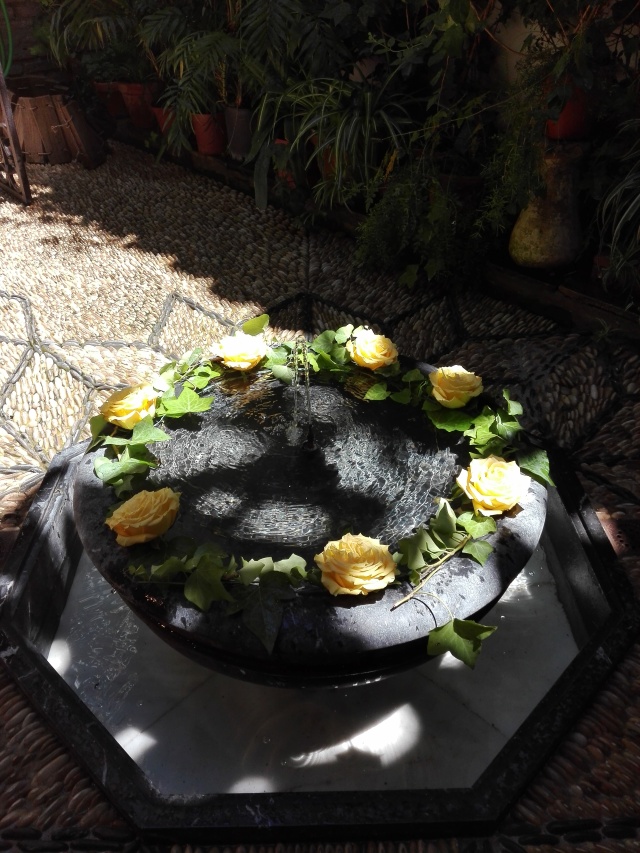I stumbled across Casa Andalusí in Córdoba inadvertently when looking for things to show my parents one scorching hot day in July last year. We had been around the spice- fragranced and leather draped markets all morning but now, at mid-day, it was time to seek refuge from the fierce Andaluz summer sun.
The fee to enter is only 3 euros 50 and it can be seen in its entirety in only an hour, leaving you plenty of time to continue exploring the Jewish district of Córdoba (or, La Judería) for the rest of the day.
It is found nestled in unassuming buildings typically draped in ivy and hanging baskets filled with azalea and bougainvillea. We were actually looking for a tetería (Moorish tea shop) but so desperate for shade we decided to give it a whirl.

Casa Andalusí can be thought of as a house-museum. Opened in 1997, it serves to give visitors an evocative glimpse into how Andalusian homes would have looked in the 12th century. It is compact and so easy to navigate quite quickly but full of things to absorb and feel. Those familiar arches as seen all over Andalucía and most famously in the Mezquita frame the patio along with sprawling ivy and intricately etched façades.
Patios were the most integral feature of any Andalucían home and still are today. The moment you enter the patio of Casa Andalusí you are greeted with that ever-calming sound of running water from the small fountain which was artfully laced with yellow roses on the day I visited. It’s funny how even the presence of water, even if not physically felt, provides the placebo feeling of coolness in a city which is so incredibly hot in the summer months.

We weaved in and out of the rooms viewing the impressive artefacts laying around either openly or in glass cases. It never fails to astound me to see articles from centuries ago preserved and available for us contemporary people to view.
Things as innocuous as chess pieces or bangles were once used by other people that came before us and it just blows my mind, I always try to visualise it!
There is a mix of Roman and Moorish artefacts along with other modern reconstructions of how the house and houses like it would have been such as the silver engraved tea platters and glass tea receptacles that I saw all over Marrakech, a sensual reminder of the North African that is omnipresent in Andalucía and in Córdoba in particular, owing to its past as the capital of the Islamic Caliphate. It is crazy that a relatively small Spanish town often overshadowed by Seville once had such influential power over a now defunct empire.
“The moment you enter the patio of Casa Andalusí you are greeted with that ever-calming sound of running water from the small fountain which was artfully laced with yellow roses on the day I visited. It’s funny how even the presence of water, even if not physically felt, provides the placebo feeling of coolness in a city which is so incredibly hot in the summer months.”

There is a back corridor where you can see Roman artefacts but unfortunately I don’t have photos of these. We walked through to a costume area where you can try on the typical costumes from the al-Andalus era or even buy them if you so wish!
Casa Andalusí opened in 1997 but it does a great job in making the visitor feel immersed in its antiquated past. It is no-frills and I love this- if I loathe anything it’s contrived and forged-ness (couldn’t think of the noun so this will have to do).
I can see how it could be easily overlooked due to the fame of other outstanding monuments here such as the Mezquita or the Alcázar. I would however, recommend that any traveller who thrives off seeing things off the typical tourist trail should come here and get a pretty authentic glimpse into the homely set-up of casas andaluces and it is just SO affordable!


So that’s it! Just a short blog post this time to introduce potential visitors to something really worth visiting which you often wouldn’t find it Córdoba visitor’s guides.
Casa Andalusí
Calle Judíos, 12



Pingback: A Walk Around La Judería of Córdoba (the Jewish quarter/old town) – Laura in Andalucía